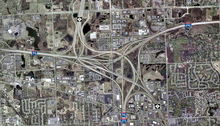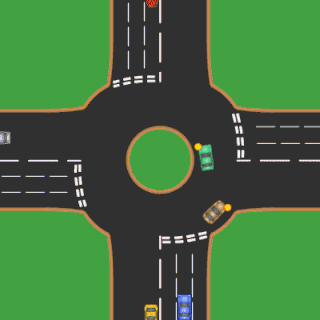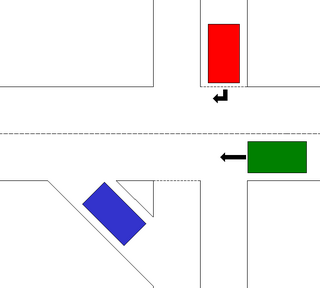
A junction is where two or more roads meet.

A junction is where two or more roads meet.
Roads began as a means of linking locations of interest: towns, forts and geographic features such as river fords. Where roads met outside of an existing settlement, these junctions often led to a new settlement. Scotch Corner is an example of such a location.
In the United Kingdom and other countries, the practice of giving names to junctions emerged, to help travellers find their way. Junctions took the name of a prominent nearby business or a point of interest.
As of the road networks increased in density and traffic flows followed suit, managing the flow of traffic across the junction became of increasing importance, to minimize delays and improve safety. The first innovation was to add traffic control devices, such as stop signs and traffic lights that regulated traffic flow. Next came lane controls that limited what each lane of traffic was allowed to do while crossing. Turns across oncoming traffic might be prohibited, or allowed only when oncoming and crossing traffic was stopped.
This was followed by specialized junction designs that incorporated information about traffic volumes, speeds, driver intent and many other factors.
The most basic distinction among junction types is whether or not the roads cross at the same or different elevations. More expensive, grade-separated interchanges generally offer higher throughput at higher cost. Single-grade intersections are lower cost and lower throughput. Each main type comes in many variants. [1]

At interchanges, roads pass above or below each other, using grade separation and slip roads. The terms motorway junction and highway interchange typically refer to this layout. They can be further subdivided into those with and without signal controls.
Signalized (traffic-light controlled) interchanges include such "diamond" designs as the diverging diamond, [2] Michigan urban diamond, three-level diamond, and tight diamond. Others include center-turn overpass, contraflow left, single loop, and single-point urban overpass. [3]
Non-signalized designs include the cloverleaf, contraflow left, dogbone (restricted dumbbell), double crossover merging, [2] [4] [5] dumbbell (grade-separated bowtie), echelon, free-flow interchange, partial cloverleaf, raindrop, single and double roundabouts (grade-separated roundabout), single-point urban, stack, and windmill. [3]
Autobahnkreuz (literally "autobahn cross"), short form kreuz, and abbreviated as AK, is a four-way interchange on the German autobahn network. Autobahndreieck (literally "autobahn triangle"), short form dreieck, and abbreviated as AD, is a three-way interchange on the German autobahn network.

At intersections, roads cross at-grade. They also can be further subdivided into those with and without signal controls.
Signalized designs include advanced stop line, bowtie, box junction, continuous-flow intersection, [6] continuous Green-T, double-wide, hook turn, jughandle, median u-turn, Michigan left, paired, quadrant, seagulls, slip lane, split, staggered, superstreet, Texas T, Texas U-turn and turnarounds. [3]
Non-signalized designs include unsignalized variations on continuous-flow 3 and 4-leg, median u-turn and superstreet, along with Maryland T/J, roundabout and traffic circle. [3]
In the EU it is estimated that around 5,000 out of 26,100 people who are killed in car crashes are killed in a junction collision, in 2015, while it was around 8,000 in 2006. [7] During the 2006–2015 decade, this means around 20% of road fatalities occur at junctions. [7]
By kind of users junctions fatalities are car users, 34%; pedestrians, 23%; motorcycle, 21%; pedal-cycle 12%; and other road users, the remaining. [7]
It has been considered that several causes might lead to fatalities; for instance: [7]
A number of features make this protected intersection much safer. A corner refuge island, a setback crossing of the pedestrians and cyclists, generally between 1.5–7 metres of setback, a forward stop bar, which allows cyclists to stop for a traffic light well ahead of motor traffic who must stop behind the crosswalk. Separate signal staging or at least an advance green for cyclists and pedestrians is used to give cyclists and pedestrians no conflicts or a head start over traffic. The design makes a right turn on red, and sometimes left on red depending on the geometry of the intersection in question, possible in many cases, often without stopping. [8]
Cyclists ideally have a protected bike lane on the approach to the intersection, separated by a concrete median with splay kerbs if possible, and have a protected bike lane width of at least 2 metres if possible (one way). In the Netherlands, most one way cycle paths are at least 2.5 metres wide. [9]
Bicycle traffic can be accommodated with the low grade bike lanes in the roadway or higher grade and much safer protected bicycle paths that are physically separated from the roadway.
In Manchester, UK, traffic engineers have designed a protected junction known as the Cycle-Optimised Signal (CYCLOPS) Junction. This design places a circulatory cycle track around the edge of the junction, with pedestrian crossing on the inside. This design allows for an all-red pedestrian / cyclist phase with reduced conflicts. Traffic signals are timed to allow cyclists to make a right turn (across oncoming traffic) in one turn). It also allows for diagonal crossings (pedestrian scramble) and reduces crossing distances for pedestrians. [10]
Intersections generally must manage pedestrian as well as vehicle traffic. Pedestrian aids include crosswalks, pedestrian-directed traffic signals ("walk light") and over/underpasses. Walk lights may be accompanied by audio signals to aid the visually impaired. Medians can offer pedestrian islands, allowing pedestrians to divide their crossings into a separate segment for each traffic direction, possibly with a separate signal for each.

Traffic comprises pedestrians, vehicles, ridden or herded animals, trains, and other conveyances that use public ways (roads) for travel and transportation.

A roundabout, also known as a rotary or traffic circle, is a type of circular intersection or junction in which road traffic is permitted to flow in one direction around a central island, and priority is typically given to traffic already in the junction.

An intersection or an at-grade junction is a junction where two or more roads converge, diverge, meet or cross at the same height, as opposed to an interchange, which uses bridges or tunnels to separate different roads. Major intersections are often delineated by gores and may be classified by road segments, traffic controls and lane design.

Traffic lights, traffic signals, or stoplights – also known as robots in South Africa – are signalling devices positioned at road intersections, pedestrian crossings, and other locations in order to control flows of traffic.

A curb extension is a traffic calming measure which widens the sidewalk for a short distance. This reduces the crossing distance and allows pedestrians and drivers to see each other when parked vehicles would otherwise block visibility.

In civil engineering, grade separation is a method of aligning a junction of two or more surface transport axes at different heights (grades) so that they will not disrupt the traffic flow on other transit routes when they cross each other. The composition of such transport axes does not have to be uniform; it can consist of a mixture of roads, footpaths, railways, canals, or airport runways. Bridges, tunnels, or a combination of both can be built at a junction to achieve the needed grade separation.

A diamond interchange is a common type of road junction, used where a controlled-access highway crosses a minor road.

A single-point urban interchange, also called a single-point interchange (SPI) or single-point diamond interchange (SPDI), is a type of highway interchange. The design was created in order to help move large volumes of traffic through limited amounts of space safely and efficiently.

A diverging diamond interchange (DDI), also called a double crossover diamond interchange (DCD), is a subset of diamond interchange in which the opposing directions of travel on the non-freeway road cross each other on either side of the interchange so that traffic crossing the freeway on the overpass or underpass is operating on the opposite driving side from that which is customary for the jurisdiction. The crossovers may employ one-side overpasses or be at-grade and controlled by traffic light.

In the field of road transport, an interchange or a grade-separated junction is a road junction that uses grade separations to allow for the movement of traffic between two or more roadways or highways, using a system of interconnecting roadways to permit traffic on at least one of the routes to pass through the junction without interruption from crossing traffic streams. It differs from a standard intersection, where roads cross at grade. Interchanges are almost always used when at least one road is a controlled-access highway or a limited-access divided highway (expressway), though they are sometimes used at junctions between surface streets.

An advanced stop line (ASL), also called advanced stop box or bike box, is a type of road marking at signalised road junctions allowing certain types of vehicle a head start when the traffic signal changes from red to green. Advanced stop lines are implemented widely in Denmark, the United Kingdom, and other European countries but the idea was first conceptualized by transportation planner Michael Lynch for the city of Portland, Oregon, in response to numerous bike crashes at intersections.

A continuous flow intersection (CFI), also called a crossover displaced left-turn, is an alternative design for an at-grade road junction. Vehicles attempting to turn across the opposing direction of traffic cross before they enter the intersection. No left turn signal in the intersection is then necessary. Instead, vehicles traveling in both directions can proceed, including through vehicles and those turning right or left, when a generic traffic signal/stop sign permits.
Road signs in Sweden are regulated in Vägmärkesförordningen, VMF (2007:90), and are to be placed 2 metres from the road with the sign 1.6 m from the base for motorized roads. Except for route numbers, there are a maximum of three signs on a pole, with the most important sign at the top. All signs have a reflective layer added on selected parts of the sign as is custom in European countries; most larger signs also have their own illumination.

In traffic engineering, there are regional and national variations in traffic light operation. This may be in the standard traffic light sequence or by the use of special signals.

A quadrant roadway intersection adds an additional "quadrant roadway" between two legs of an intersection. This roadway adds two three-way intersections in addition to the original four-way intersection, moving all left turns or right turns from the main intersection. The design is intended to improve traffic flow by reducing signal timing phases from four to two in the main intersection. The design is intended for intersections where large artery routes meet in an area of dense development and high pedestrian volume.

In road design, a slip lane, also known as a filter lane in the United Kingdom, is a road at a junction that allows motorists to change roads without actually entering an intersection.
Traffic signs, installations, and symbols used in Germany are prescribed by the Road Traffic Regulations (StVO) and the Traffic Signs Catalog (VzKat).

Cycling infrastructure is all infrastructure cyclists are allowed to use. Bikeways include bike paths, bike lanes, cycle tracks, rail trails and, where permitted, sidewalks. Roads used by motorists are also cycling infrastructure, except where cyclists are barred such as many freeways/motorways. It includes amenities such as bike racks for parking, shelters, service centers and specialized traffic signs and signals. The more cycling infrastructure, the more people get about by bicycle.

A protected intersection or protected junction, also known as a Dutch-style junction, is a type of at-grade road junction in which cyclists and pedestrians are separated from cars. The primary aim of junction protection is to make pedestrians and cyclists safer and feel safer at road junctions.

Terminology related to road transport—the transport of passengers or goods on paved routes between places—is diverse, with variation between dialects of English. There may also be regional differences within a single country, and some terms differ based on the side of the road traffic drives on. This glossary is an alphabetical listing of road transport terms.